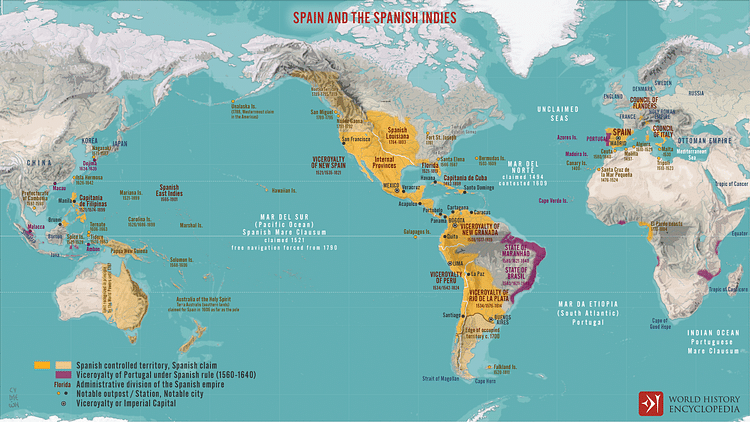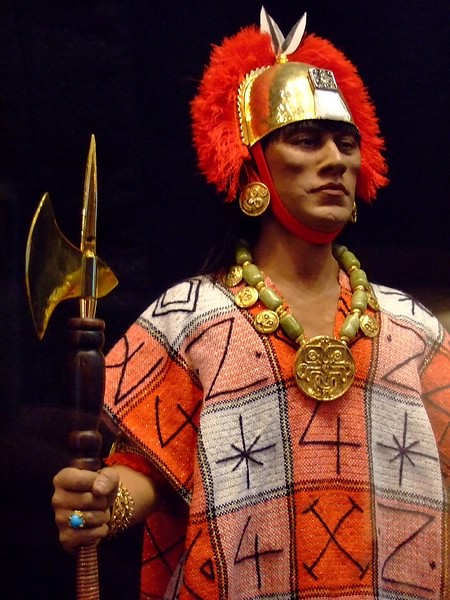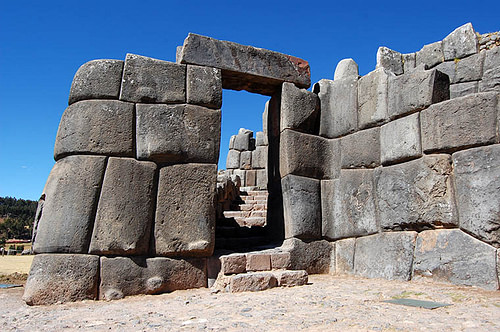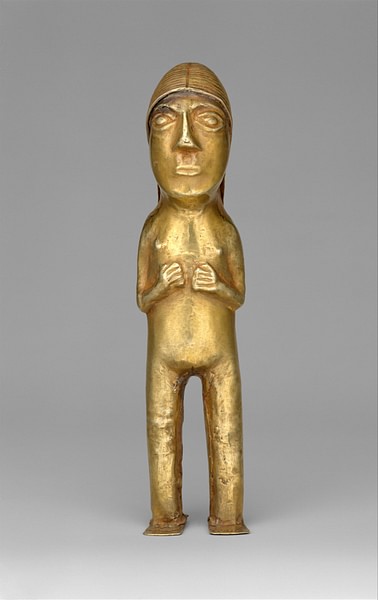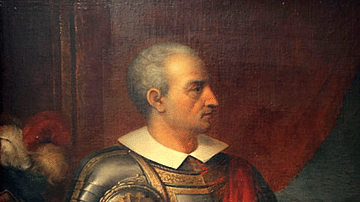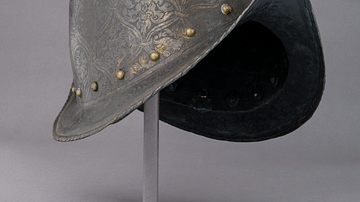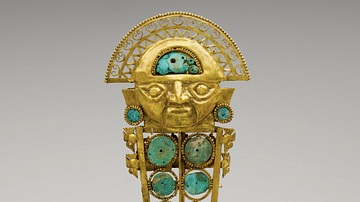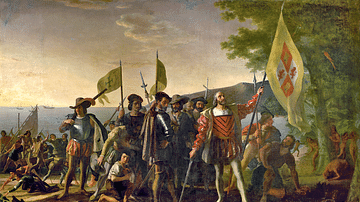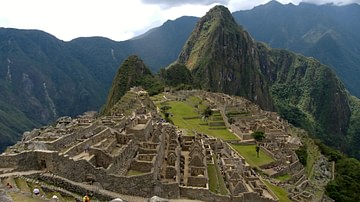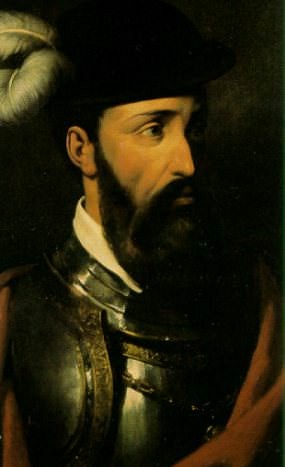
Francisco Pizarro (c. 1478-1541) was a conquistador who led the Spanish conquest of the Inca civilization from 1532. With only a small group of men, Pizarro took advantage of his superior weapons and the fact that the Incas were weakened by civil war and the arrival of European diseases to take over the largest empire in the world.
Pizarro captured the Inca capital of Cusco, executed the Inca ruler Atahualpa, and exploited the widespread discontent with Inca rule by indigenous South Americans. Things then fell apart for the invaders when they began to fight amongst themselves for the glittering riches of a crumbling empire. Pizarro was murdered in his home in Lima by a rival Spanish faction in June 1541.
Early Life
Francisco Pizarro was born in 1478 in Trujillo, Extremadura, Spain. Of humble background, Francisco was the illegitimate son of Gonzalo Pizarro (d. 1522), a Spanish colonel; his mother, Francisca González y Mateos, was the daughter of a local farmer. Growing up in circumstances that did not allow him to attend school or be accepted by society, Francisco never even learnt to read or write. With few advantages to a life in Spain, it is little surprise that Francisco, like many of his generation, was attracted by the promise of fame and fortune offered by the New World.
In 1502, Francisco sailed with Nicolás de Ovando (b. 1451) to Hispaniola (modern Dominican Republic/Haiti), a Spanish colony since 1494. By 1509, Francisco had moved on to the mainland, where he joined the expedition led by Alonso de Ojeda (1468-1515) to the Gulf of Uraba off the coast of what is today Colombia. Packing in the sights, if not the riches of the New World, Francisco joined the expedition of Vasco Nuñez de Balboa (1475-1519) to cross the Isthmus of Panama in 1513. Francisco, therefore, became one of the first Europeans to see the Pacific Ocean. He then settled in Panama and enjoyed a successful political career there, serving as a magistrate and the inspector of encomiendas (the right to exploit local forced labour in a specific area).
The historian C. Howard gives the following description of Francisco Pizarro:
Pizarro was a lean man with a stern, lined face, graying hair, and a pointed, well-kept beard. Those who knew him said that he was prudent and discerning, even temperate - in almost everything but his appetite for gold. Yet none would question that he was a man who demanded much of himself, and therefore, much of his men.
(12)
The First Expeditions South
Well-established and well-connected in Panama, Pizarro was able to think about launching his own expeditions of discovery. Rumours drifted north that a great and golden empire lay in the unknown lands to the south. Pizarro raised the necessary funds to lead an expedition there in 1524-5. He explored the northern coast of South America and attempted to sail up the Biru River but could make little headway against difficult winds and currents. The group then met a hostile tribe at Punta Quemado, where Pizarro received seven wounds and a number of his men were killed.
Pizarro launched another expedition in March 1526. Sailing to the San Juan River, Pizarro marched inland but was this time blocked by swamps. Meanwhile, Pizarro's pilot, Bartolomé Ruiz, had sailed across the equator (the first European to do so in the Pacific), where he had come across a balsa craft loaded with trade goods, including gold artefacts. At last, the conquistadors had a sign that riches could be theirs if only they could find the source. Ignoring orders from the governor to return to Panama, Pizarro kept a volunteer force and sailed on to the Gulf of Guayaquil (where the coasts of Ecuador and Peru meet). There he discovered the bustling port of Tumbes. Here was further evidence of the presence of a great civilization and that there really was something in South America worth going after. First, he would have to return to Spain and obtain royal approval for his next and larger expedition to try and emulate the discoveries of his compatriot Hernán Cortés (1485-1547) in Mexico, who had conquered the Aztec civilization. Pizarro was already into his 50s; this would be his last shot at fame and glory.
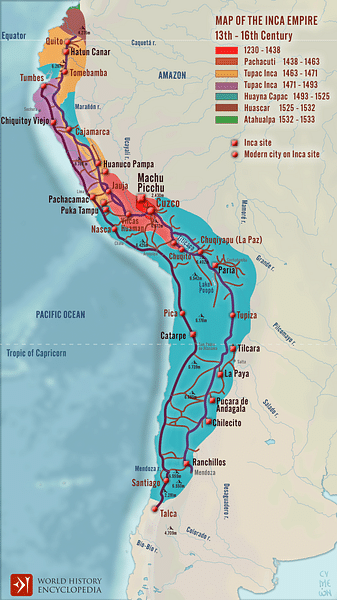
Conquest of the Incas
In July 1529, Pizarro was successful in demonstrating the potential of South America for the Spanish Crown. First, he was made a Knight of Santiago and then he was awarded the status of adelantado, which was the legal right given by the King of Spain, Charles V, Holy Roman Emperor (r. 1519-56), to become the governor of any new lands he colonised there. Pizarro could also keep four-fifths of the wealth acquired in the process. His other obligations included building fortresses to keep possession of the new colony he established and taking clergymen to spread Christianity.
Pizarro organised his third expedition throughout 1530, and he set off once more into the unknown in December of that year. Pizarro led fewer than 200 fighting men to the Andes. His second-in-command was Diego de Almagro (c. 1475-1538), who had been on his two previous voyages south. Sailing from Panama down the coast of Colombia and Ecuador in two caravel ships, the Europeans pillaged all along the way, the team marching on land being shadowed by the ships off the coast. Pizarro waited for reinforcements at Coaque (Ecuador) in February 1531 so that his force eventually numbered 260 men. The mini-army slowly marched south, conquered Tumbes in February 1532, and then struck inland. The invaders noted the well-built roads and storehouses along the way, sure indicators they were encroaching into the lands of a wealthy empire. Finally, on 15 November 1532, first contact was made with the Inca people, and Pizarro sent word he wished to speak with their king at Cajamarca in the highlands of Peru.
Two factors would help Pizarro enormously in his conquest. The first was the epidemic of European diseases that had already reached South America from Mexico and Central America. This wave killed a staggering 65-90% of the population. The Inca ruler Wayna Qhapaq had himself succumbed in 1528, and this led to the second point in the conquistadors' favour: the inherent fragility of the Inca Empire. Wayna Qhapaq's two sons, Waskar and Atahualpa, now fought each other for control of the empire, then the largest in the world but woefully imbalanced, with 40,000 Incas ruling 10 million subject people. The damaging civil war, which lasted 6 years, highlighted the struggle the Incas had in trying to control a vast empire of many subject peoples who were not at all keen on being ruled by the Incas, who imposed their taxes, religion, and even art on conquered peoples.
Atahualpa had won the civil war, and it was he who met with Pizarro. First contact was friendly with drinks, a horse display, and speeches, but Pizarro revealed his ruthless intentions the very next day when he attacked Atahualpa and his army of 80,000 men. European gunpowder weapons brought total victory: 7,000 Incas were killed, with no Spanish losses at all.
Atahualpa was captured in the battle and had to provide a massive treasure store to secure his release. The Incas provided the gold and silver, but Pizarro ordered Atahualpa's execution anyway on 26 July 1533 – an act for which he would be rebuked by Charles V. Pizarro may have claimed that, given the Incas' absolute reliance on a hierarchical system of rule, the execution was fundamental to taking over the empire as easily as possible. In the event, even when the Incas resisted, their weapons and tactics were no match for steel, cavalry, and gunpowder. Atahualpa's ransom was duly melted down and distributed out amongst the Spaniards. An infantryman received the enormous sum of 20 kilos of gold, while a cavalryman got 41 kilos; Pizarro gave himself seven times that of a cavalryman, and the Crown was allotted its one-fifth as promised. As Diego de Almagro arrived with his force after the taking of Atahualpa, he and his men were not given any of the spoils, which caused a bitter resentment that would come back to haunt Pizarro.
The Inca Fightback: Cusco & Lima
Pizarro now turned his attention to the wider empire and the hope of golden cities ripe for the taking. Reconnaissance missions were sent out in all directions, and one of the most interesting was led by Pizarro's brother Hernando, who reported of a great city of gold and silver to the south. This was Cusco, the Inca capital. The city was the administrative, religious, and literal geographical centre of the Inca world, with the sacred Coricancha (Qorikancha) complex, large ceremonial plazas, and the massive Sacsayhuamán (Saqsawaman) fortress. With help from local peoples eager to see the fall of the Incas, Pizarro marched to Cusco, and the city was taken with ease on 15 November 1533. The Coricancha was stripped of its golden sheeting, and anything else of value was pocketed, from exotic feathers to emeralds. Sharing out the spoils with his men, Pizarro was eager to find more treasure cities. He left Cusco in the hands of his brothers and a puppet Inca ruler while he headed for the coast.
On 18 January 1535, Pizarro established Ciudad de Los Reyes (Lima), named to honour the Spanish monarch and the Magi of the Bible story, since the Spanish arrived on the day of Epiphany. Lima now became the main Spanish stronghold and eventually the capital of the Viceroyalty of Peru. As 1535 wore on, unsettling developments occurred, which pitched Pizarro and his deputy Almagro into an even fiercer state of rivalry.
Pizarro had made Almagro lieutenant-governor of Cusco in January 1535, but the deputy wanted much more than this. Even worse, Charles V now decided that the new colony should be split between Pizarro and Almagro, with the former taking the northern half and Almagro the southern half. Just who controlled Cusco in this plan – located roughly in the middle – was left dangerously unclear. As a consequence of his new right to half the colony, Almagro left Cusco in July to explore what is today Chile and what became known to the Spanish as New Toledo.
Meanwhile, back in Cusco, Pizarro's second puppet Inca ruler proved a disaster (the first had died of illness). Manco Inca Yupanqui (Manqo Inka) had been crowned by Pizarro himself on 16 November 1533. Manco, pushed by his people to react against the avaricious invaders, left Cusco on the pretext of taking a religious pilgrimage but then returned with an army to encircle the city. The siege of Cusco in 1536-7 involved tens of thousands of Inca warriors attacking their own capital, now held by a force of fewer than 200 fighting Spaniards supported by perhaps 2,000 local peoples who were against the Incas.
On 6 May, Manco Inca ordered a full-scale assault. The Sacsayhuamán fortress was taken, and hot stones were fired by sling into the thatched roofs of the city below, causing a massive and destructive fire to rage. The Spanish cavalry proved, as usual, to be all but invincible, and the Europeans survived the attacks and even began to make forays out of the city for vital supplies. The Inca armies, made up mostly of conscripted farmers, could not stay in the field indefinitely, and Manco Inca was obliged to lift and then restart the siege once the harvests had been brought in. In the meantime, Pizarro sent two relief columns from Lima, but both were wiped out. Pizarro was later criticised for not waiting to form a single larger force to relieve the capital. A third force composed of reinforcements from Central America and the return of Almagro from Chile ensured the conquistadors held on to the prize of Cusco in April 1537.
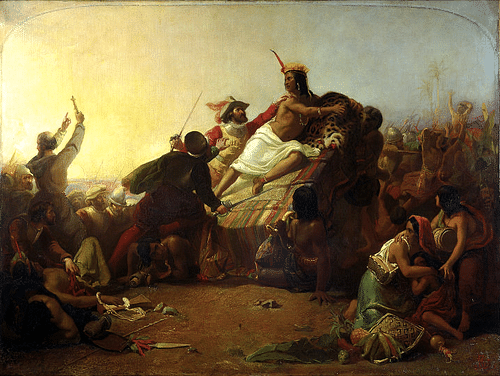
The Inca leadership had also been orchestrating a coordinated uprising across the empire. Many lone conquistadors who had set themselves up as farmers were killed. The Inca general Quizo Yupanqui led an assault on Lima in September 1536, but the Spanish cavalry once again caused tremendous damage to the enemy, and when the conspicuously dressed and front-positioned Inca high command was targeted and then eliminated, the rest of the army disbanded. This victory had allowed Pizarro to send the third relief column to Cusco.
The opportunity to drive out the Spanish in a series of coordinated blows had failed, and Pizarro could once more consider himself the new ruler of this vast new colony. Charles V bestowed the title of Marquis on Pizarro. Manco Inca had not gone away as he set up an enclave of resistance in the Vilcabamba valley, where he conducted a guerrilla war for the next decade. Pizarro was utterly ruthless during this war, particularly with captured prominent Incas. Cura Ocllo, the wife of Manco Inca, was captured, tortured, and executed, while the leaders Willaq Umu and Tisoq were both burned alive. On the other side, when Manco Inca could not ambush Spaniards directly he burned crops to starve them. This latter strategy caused a famine in southern Peru in 1540-41 that killed 30,000 indigenous people.
The last great hope of the Incas was that the unbeatable conquistadors would destroy themselves. The Almagro-Pizarro rivalry, which ran through a second generation, had initially looked like this hope was not a forlorn one. Almagro had imprisoned Hernando Pizarro following his return to Cusco on 25 July 1537, but the battle outside Cusco that followed between the Pizarros and Almagristas – the Battle of Las Salinas in April 1538 – proved indecisive in settling the split in the conquistadors. Almagro was later outmanoeuvred and, on the orders of Hernando, executed by strangulation for his audacity on 8 July 1538. This action against his old expedition comrade was not approved by Francisco Pizarro.
To consolidate his domination of the Incas, Pizarro took as his mistress Cusirimay Ocllo (aka Doña Angelina Añas Yupanque), a niece of Wayna Qhapaq and the child-bride of Atahualpa. The couple had two sons. Still, neither the threat from rebellious Incas nor the infighting conquistadors had gone away. The Spanish takeover of Peru, after such an easy start, was becoming a very messy affair indeed.
New Castille
Manco Inca's brother Paullu was made the new puppet ruler of the Incas, and the colony became the Viceroyalty of New Castille in 1542 (later called the Viceroyalty of Peru). Through clever political manoeuvrings, sound military strategy, and sheer audacity and bravura, Pizarro had conquered an empire. Keeping hold of his massive gains, though, was to prove a test too far.
Pizarro's dislike of new faces, bureaucracy, and administrative interference from Spain meant that he did not surround himself with the people best able to govern a colony. Another flawed strategy was to overly favour his own family. Pizarro handed out encomiendas like confetti. He gave his younger brother Gonzalo Pizarro (1506-1548) the title of Governor of Charcas (later renamed Sucre), effectively most of what is today Bolivia. This nepotism spread discontent amongst the other conquistadors, particularly those loyal to the late Almagro who were now outcasts and found themselves no better off in the colony than newcomers from Europe. On 26 June 1541, Pizarro was stabbed to death in his home by a group loyal to Almagro, which included the latter's son. The Marquis' body was interred in the cathedral of Lima.
Pizarro had been the victim of his own political machinations and had finally fallen, not at the hands of the people he had conquered, but at the hands of his own people. Gonzalo Pizarro now named himself his brother's successor and so became the governor of Peru, but Almagro's son still claimed rights over Cusco. The stalemate was not finally resolved until September 1542 and the arrival of Cristóbal Vaca de Castro with orders from Spain that he take up the position as governor of Peru, but even then the infighting rumbled on until the Spanish Crown took full control of its colony in 1554.
